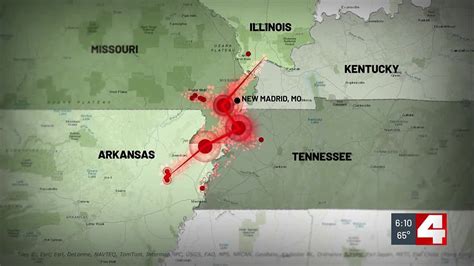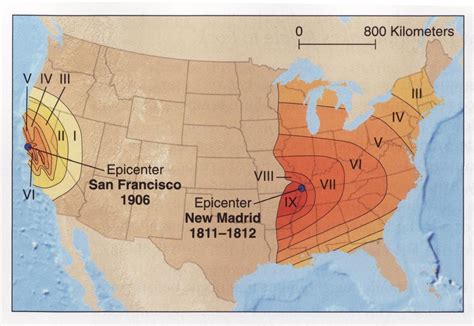The New Madrid Fault Line is a major seismic zone in the central United States, stretching from northeastern Arkansas to southern Illinois, with its impact felt across parts of eight states, including Alabama, Arkansas, Illinois, Indiana, Kentucky, Mississippi, Missouri, and Tennessee. This region has experienced significant earthquakes in the past, with the most notable series of events occurring from 1811 to 1812, which included seven earthquakes with magnitudes of 7.0 or greater. Understanding the geography and seismic activity of the New Madrid Fault Line is crucial for assessing earthquake risks and preparing for potential future events.
Geological Overview of the New Madrid Seismic Zone

The New Madrid Seismic Zone (NMSZ) is not a single fault but rather a complex system of faults that run beneath the region. It is located in the central part of the North American plate, far from the tectonic plate boundaries. The primary mechanism behind the earthquakes in this region is believed to be related to the adjustment of the Earth’s crust in response to the collapse of the Reelfoot Rift, a failed rift that formed about 500 million years ago. Over time, the forces causing the rifting process were reversed, leading to the formation of faults and stress buildup in the region.
Significant Earthquakes and Their Impact
The most significant series of earthquakes in the New Madrid region occurred in the winter of 1811-1812. These events, known as the New Madrid earthquakes, included several major shocks that were felt across much of the eastern United States. The largest of these earthquakes is estimated to have had a magnitude of around 7.7, with some reports suggesting it may have been even higher. These earthquakes caused widespread destruction, altered the course of the Mississippi River, and created Reelfoot Lake in Tennessee. The impact of these earthquakes was so profound that they were felt as far away as Washington, D.C., and Charleston, South Carolina.
| Year | Magnitude | Location | Impact |
|---|---|---|---|
| 1811 | 7.4-7.7 | NE Arkansas | Significant destruction, river course changes |
| 1812 | 7.0-7.3 | MO-AR border | Continued destruction, seismic aftershocks |
| 1968 | 5.4 | Southern IL | Minor damage, felt across several states |

Mapping the New Madrid Fault Line

MAPPING the New Madrid Fault Line involves identifying the complex network of faults and understanding the seismic activity in the region. Maps of the area highlight the various fault lines, including the New Madrid North Fault, the New Madrid South Fault, and other associated faults. These maps are crucial for emergency planning, construction regulations, and public awareness campaigns. By studying the fault lines and their history of activity, researchers and policymakers can better prepare the region for potential future earthquakes.
Preparation and Mitigation Efforts
Given the potential for significant earthquakes, preparation and mitigation efforts are critical in the New Madrid Seismic Zone. This includes implementing and enforcing building codes that account for seismic activity, conducting public education campaigns about earthquake risks and safety measures, and developing emergency response plans. Furthermore, regular seismic monitoring and research into the region’s tectonic history and seismic hazard help in refining predictive models and improving preparedness.
Key Points
- The New Madrid Fault Line is a significant seismic zone in the central United States.
- It has a history of major earthquakes, including the 1811-1812 series, which had profound regional and national impacts.
- Understanding the geological and tectonic context of the region is crucial for assessing and mitigating earthquake risks.
- MAPPING and studying the fault lines contribute to better emergency planning and public awareness.
- Preparation and mitigation efforts, including seismic-resistant construction and public education, are essential for reducing the impact of future earthquakes.
As research and monitoring continue, the understanding of the New Madrid Fault Line and its potential for seismic activity evolves. This knowledge is critical for the millions of people living in the region, as well as for national disaster preparedness and mitigation strategies. By integrating historical data with current seismic activity and predictive models, the region can better prepare for the possibility of future significant earthquakes, ultimately saving lives and reducing damage.
What is the New Madrid Fault Line?
+The New Madrid Fault Line is a seismic zone in the central United States, known for its history of significant earthquakes, including the major events of 1811-1812.
Where is the New Madrid Fault Line located?
+It stretches from northeastern Arkansas to southern Illinois, affecting parts of eight states.
What are the risks associated with the New Madrid Fault Line?
+The primary risk is the potential for significant earthquakes that could cause widespread damage and loss of life across the central United States.



